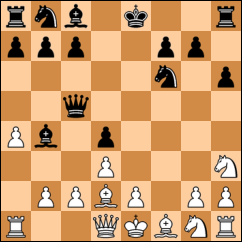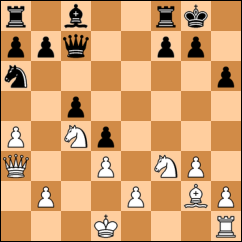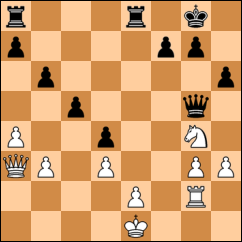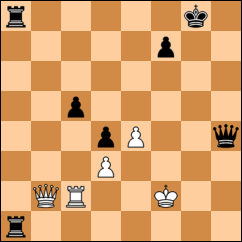S.Black–K.Ammann
Route 20 Chess Club
Freeport, Illinois, Jan. 5, 2010
1.d3 e5 2.Nc3 d5 3.f3 d4 4.Ne4 Nf6
It didn't occur to me simply to grab space with 4...f5.
5.Ng5? Qd7
I could have played 5...Bb4!?, but trading bishops (6.Bd2 Bxd2+ 7.Qxd2) seemed premature.
6.Bd2 h6 7.N5h3 Be7 8.f4 exf4 9.Bxf4 Bb4+
There. If I'm going to check him, may as well screw with his development, right?
10.Bd2 Qb5
I still wasn't ready to initiate the trade.
11.a4??
A paper tiger. Better is 11.c3!? Ba5 12.Qc1, threatening 13.cxd4.
11...Qc5
Fritz prefers 11...Bxd2!? 12.Qxd2 Qxb2 13.Rc1, but I had my eye on the possibility of a clash over c3, ending with a king-rook queen fork. Steve threw a wrench in that plan, though, with his next move.
12.Nf3
If Steve gets to the d4-pawn first, my chances in the fight for c3 are bollixed -- I can't bring my c-pawn forward to protect it, and if I recapture on d4 with a piece, c3 is a pawn fork. I have to come up with some ingenious counterplay, and fast.
12...Ng4
12...Nd5 preserves the balance of power on c3 more effectively. Actually, Fritz's analysis points out the hole in my battle plan over that square: 13.c3 dxc3 14.bxc3 Bxc3 15.Rc1! Bxd2+ 16.Qxd2 leaves black a pawn up but white with the initiative. But as it happened, I lucked out.
13.Nf2? Ne3 14.Qb1 Nxc2+ 15.Kd1 Nxa1 16.Qxa1 Bxd2
Now it's time to trade bishops!
17.Ne4
Steve is still determined to get that pawn.
17...Qb6 18.Nexd2 c5 19.Nc4 Qc7
Steve is frustrating my development, but on the upside, that's about as far forward as his knight can get with support. I figure I have a little time to catch up, but it's hard to decide what order to do things in.
20.Qa3 Na6 21.g3 0-0 22.Bg2
I see the threat along the diagonal and decide -- not entirely correctly -- that I have one free move before I have to do anything about it.
22...b6 23.Nfe5
Steve could have regained the initiative with 23.Nxd4 Bb7 24.Nb5.
23...Bb7 24.Rg1 Bxg2 25.Rxg2 Nb4
Beginning the trek to a handsome outpost square, which I know Steve won't let me keep . . . but I'm up the exchange plus a pawn, so I'm cheerfully trading away whatever I can.
26.b3 Nd5 27.Ke1 Ne3 28.Nxe3 Qxe5
I think I surprised Steve here by not retaking on e3. My pawn chain was doing such a nice job penning in his queen, I didn't want to mess with it.
29.Ng4 Qg5 30.h3 Rfe8
And I've finally finished my development. Time to relax . . . and make that trademark blunder!
31.a5 Re7
Frankly, I was surprised that Fritz didn't give this even a single question mark. On my scoresheet, I gave it four. I played ...Re7 immediately after noting to myself that I couldn't play ...Re7, because the pawn swap would leave my a8-rook unprotected on the open file with white to play.
Note to self: Never relax.
Steve, meanwhile, was rejoicing that I'd finally made the mistake he'd been waiting for me to make. The joy was short-lived, though.
32.axb6 Qd5
An initiative move that also defends my a8-rook. I won't try to claim undue credit: I lucked out.
33.Rh2 axb6 34.Qb2 Rea7
I was so happy to get my rooks doubled on an open file, I missed the power of 34...Qf3!, safe because of the pin on the e-pawn.
35.e4 Qg5
I didn't think of the en passant capture 35...dxe3 until the last minute, and I dismissed it instantly because I didn't like the idea of opening the diagonal for Steve's queen. But I guess there wasn't a whole lot he could have done with it, and I would have gotten another pawn out of the deal.
36.Rd2 h5 37.h4
A crafty bit of psychology, this move tilted me enough that I didn't immediately recognize that Steve's knight is now hanging. 37...Qxg4 is mate in eight (38.Qc2 Qxg3+ 39.Kf1 Ra1+ 40.Rd1 Rxd1+ 41.Qxd1 Ra2 42.Qe2 Ra1+ 43.Qd1 Rxd1+ 44.Ke2 Re1+ 45. Kd2 Qf2#).
37...Ra1+ 38.Kf2 Qxg4
Now I see it! But now it's mate in 11, too far over the horizon for me to spot. I know the end is near, but I don't know exactly how I'm going to get there. So I start hurling pawns at Steve until something gives.
39.b4 g5 40.hxg5 Qxg5 41.bxc5 bxc5 42.Rc2 h4 (42...Qe3+ 43.Kg2 Rg1+ 44.Kh2 Qxg3# was the shortest path to mate) 43.gxh4 Qxh4+
The final breakthrough. And now the dénouement:
44.Kg2 Qh1+ 45.Kg3 Qe1+ 46.Kf4 Qe3+ 47.Ke5 Qg5+ 48.Kd6 R1a6+ 49.Kc7 Qe7# 0-1








0 comments:
Post a Comment